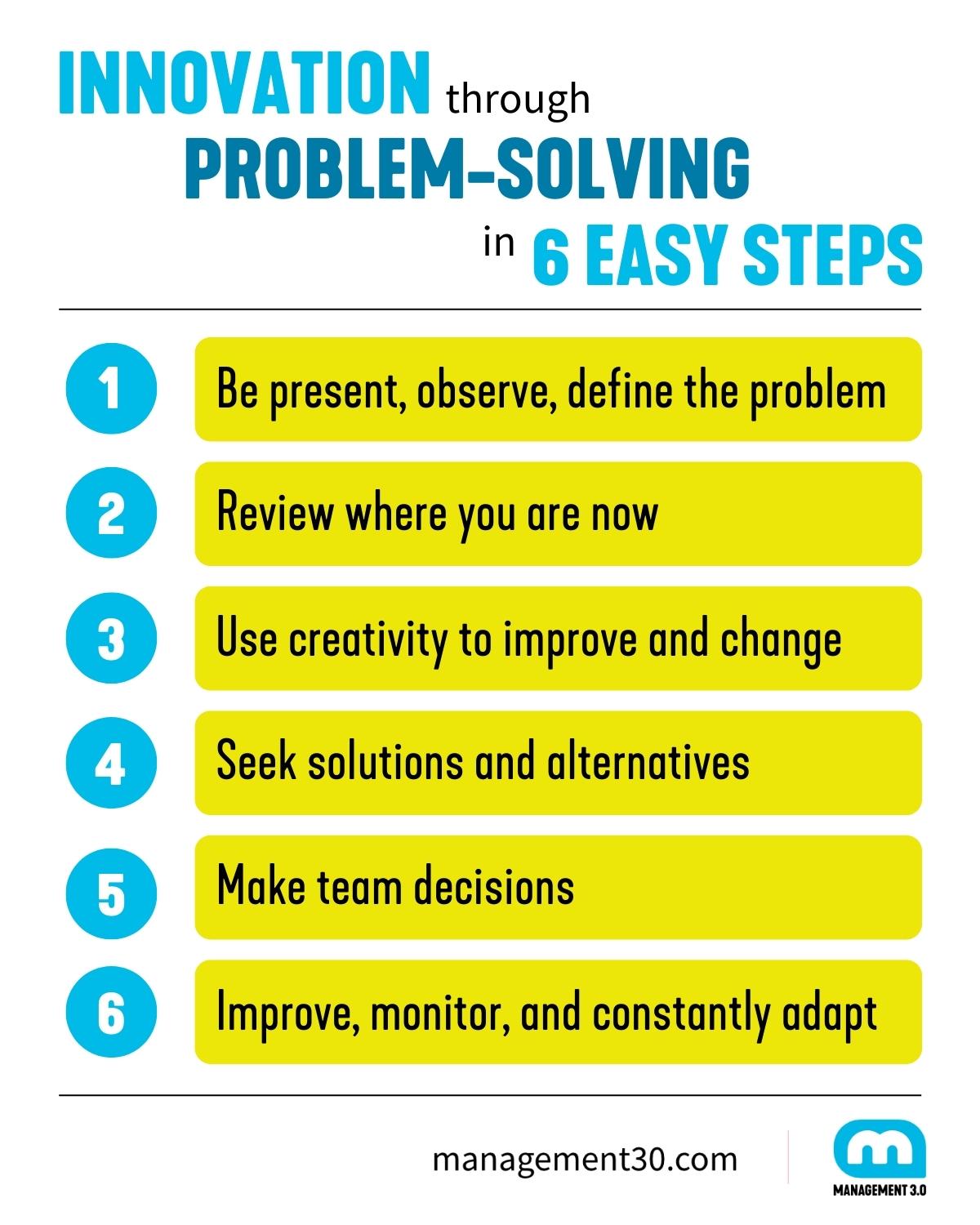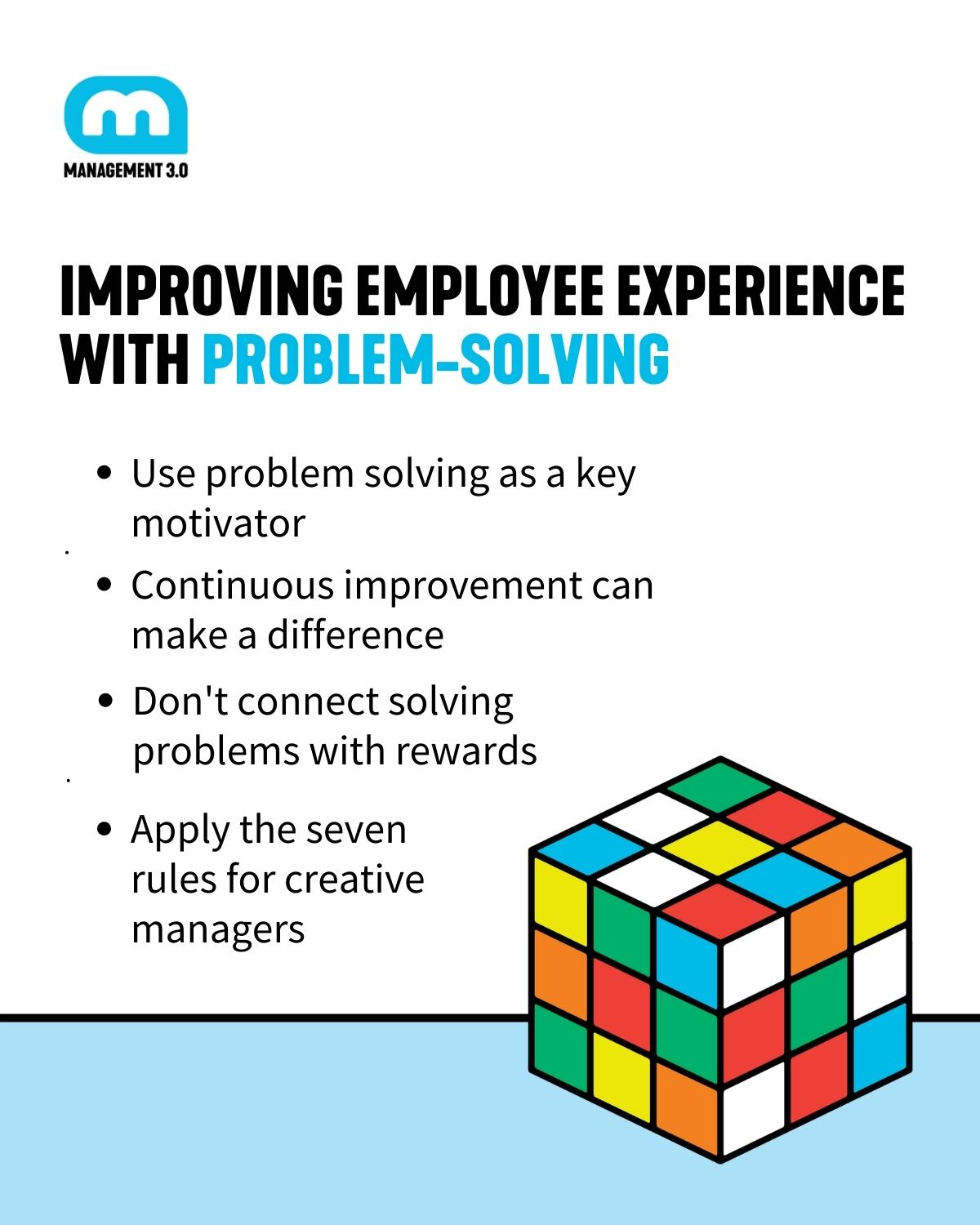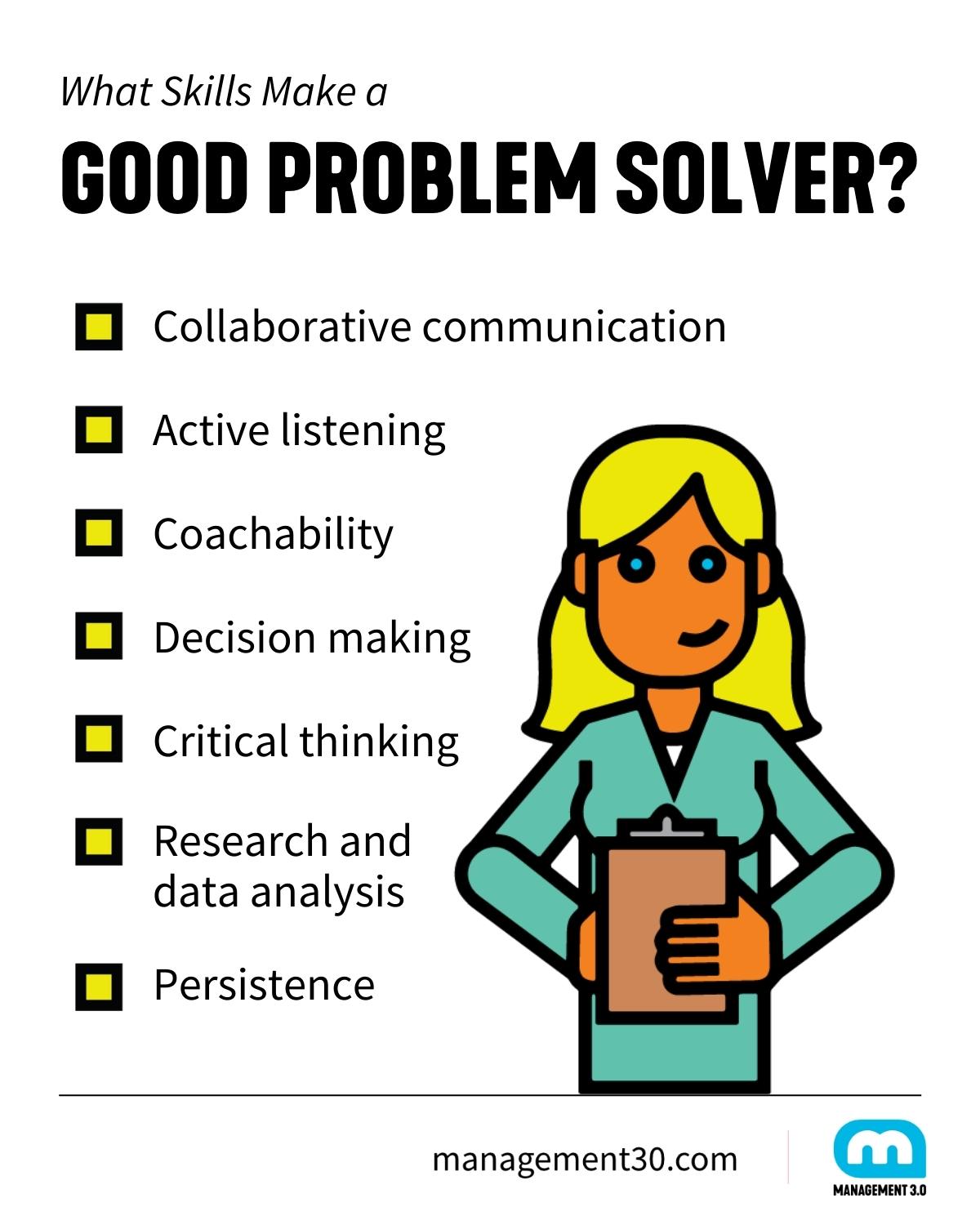According to Management 3.0 Facilitator Ilija Popjanev, problem solving is essential for individuals and organizations as it enables us to control all aspects of our business environment. In this article, Ilija looks into problem-solving skills, how the problem-solving process works, and which tools help you to advance this skill set.
In this article you will learn about:
- What is Problem Solving?
- Problem-Solving in Six Easy Steps
- Why is Problem-Solving so Important for Leaders, Teams, and Organizations?
- Problem-solving Techniques in the Workplace
- Better Employee Experience by Using Problem-Solving Tools from Management 3.0
- How do Employees Develop Problem-Solving Skills?
- What Skills Make a Good Problem Solver?
In the last few years, we have been living 100% in the VUCA world, with so many unpredictable and complex threats and challenges. As a result, organizations must create a sense of urgency to redesign their present business models and to rebuild the foundations for the future of work.
All companies now need effective problem-solving skills and tools at all levels, starting with individuals and teams, and finishing with their leaders and managers. This new reality enables growth and success only for those well-equipped and empowered by effective problem-solving skills and tools.
One of the behaviors of Management 1.0 style is to constantly look for ways to stop “fighting fires,”. Instead, the Management 3.0 style seeks to “find the root cause” of the problem, and then to refocus, improve, and plan a different way for fulfilling workplace tasks.
Management 3.0 provides effective tools and principles for building the system for effective problem solving. It provides us with techniques we can use to understand what is happening in our world, to identify things we want to change, and then apply everything that needs to be done to achieve the desired outcome. We live by the motto: fail fast, recover quickly, and learn from the failures.
The agile way of working does not mean being perfect, but instead it allows for failures and sees them as opportunities to learn, grow, and adapt. Perfection is useless if we do not provide value fast for our customers. That is why problem solving is the foundation for continuous improvement, learning, and collaboration, which leads to innovations and success in ever-changing economies and the new normal that we now live in.
What is Problem Solving?
The definition of problem solving according to the Merriam-Webster Dictionary is: “The process or act of finding a solution to a problem.” Similarly, the Oxford English Dictionary describes problem solving as: “The process of finding solutions to difficult or complex issues.”
For me, Problem-solving is a process of understanding and owning the problem, constant pursuit for solutions and improvements, and putting into action the best option for the desired outcome.
Understanding context and interacting with our teammates are the essence of effective problem-solving. We must clearly understand the complexity of our environment and the specifics of the context because things continuously change and evolve. Here, the Complexity Thinking Guidelines may help you to better understand what is happening and how to navigate complex environments more effectively.
We must have a lens through which to see problems as opportunities to improve, and regard our teams as sources of knowledge and experience. We have to connect people and opportunities in ways that can facilitate the best solutions for the problems that we are handling. Try using the Personal Maps, an excellent tool for bringing teams together and fostering diversity, respect, trust, and collaboration.
Today, all innovations and solved problems are team efforts because teams constantly improve their toolbox and competencies. Teams want to create something that was not there before, and which maximize their knowledge and resources.
To accomplish that, they need to build a process in a few easy steps:
- Be present, observe what is happening in your world, and define the problem.
- Review where you are now and what influences that state.
- Constantly improve and change things by using creative tools and tactics.
- Seek solutions and alternatives to make changes more effective.
- Make team decisions about which tools and solutions should be used.
- Implement improvements, monitor the process, and constantly adapt!

At this stage, by following the Management 3.0 principle of “Improving the system,” you can use the tools Celebration Grids, combined with Yay! Questions, to best engage the team in the problem-solving process, while keeping track of what is working well, what can be changed, and what new options exist.
Documenting everything is an integral part of the problem-solving process. By using Celebration Grids, you are gamifying the process and keeping the team flow and energy on a higher level.
Also read: What type of problem-solver are you?
Why is Problem-Solving so Important for Leaders, Teams, and Organizations?
Problem-solving is crucial for everyone: individuals, teams, leaders, organizations, and ultimately for all stakeholders because it empowers us to better control the environment and everything that is going on in our world. Try using Delegation Poker so that teams can become more empowered to solve problems both alongside leaders and within their organization.
Today, the speed of problem solving is important, and that is why organizations must give more power and authority on a team level, so employees can react quickly and even prevent problems. As a leading indicator, the Management 3.0 tool Problem Time can help you measure the time spent on uncompleted problem-solving tasks and activities; this is a valuable add-on to “lead and cycle time” lagging indicators, with which you measure the time taken on completed tasks.
Developing and refining problem-solving skills through constant practice and experimentation can refine the ability to solve problems and address issues with more complexities.
We may face various challenges in our daily work, and effective problem-solving can make a difference.
Make a Difference with Problem-Solving
- Problem-solving skills are important if you want to add more value.
As an agilist, your objective is not to be perfect but to maximize the value you provide for all stakeholders. Start fast, deliver value early, manage failures and prioritize tasks by setting the urgency criteria. - Problem-solving skills are important if you need to improve your results.
You have to accept the complexity of success factors and better understand the need for changes and improvements in a continually uncertain environment. Results depend on your problem-solving skills! - Problem-solving skills are important if you have to fix things that do not work.
When your processes are not working as planned, problem solving will give you the structure and mechanisms to identify issues, figure out why things are broken, and take actions to fix them. - Problem-solving skills are important when you have to address a risk.
Sharpen your problem-solving skills to anticipate future events better and increase the awareness of cause-and-effect relationships. This enables you to take the right actions and influence the outcomes if issues do occur. - Problem-solving skills are important if you work simultaneously on several projects.
You should apply the same problem-solving techniques when you work on multiple projects, business functions, market segments, services, systems, processes, and teams. Standardize and scale! - Problem-solving skills are important when you want to seize the day.
Problem solving is all about innovation, building new things, and changing the system into a better one. This can help us to identify opportunities even in challenging times and prepare us for the future. You can visualize the process with the Meddles Game to better understand your ideas, solutions, and activities. It is a great way to engage your team as you can build the problem-solving concept and it is an effective tool for influencing all stakeholders affected by the problem.
Also read: Collaborative Leadership explained.
Problem-solving Techniques in the Workplace
Solving complex problems may be difficult, but problems will be solved when we use the right tools. Besides the powerful Management 3.0 tools I already mentioned, as a big fan of Lean and Liberating structures, I think you can find lots of problem-solving techniques to use in your daily business.
Here is my short list of tools and techniques:
- 5 Whys – a great way to uncover the root cause is to understand the problem better.
- Fishbone analysis – for visual analysis of the root causes of a problem. Easy to combine with ‘5 Whys’ or ‘Mind mapping’ to brainstorm and determine the cause and effect of any problem.
- Silent brainstorming – gives everyone a chance to participate in idea generation as not only the loudest people, but also the quiet ones, will participate equally. Everyone’s opinion has the same weight.
- Mind maps – structured visual diagrams to share your ideas, concepts, and solutions the same way your brain does. You explain the problems quickly, then share fresh ideas, and finally come to a team consensus that can lead to an effective solution.
- Six thinking hats – enable your team to consider problems from different angles, focusing on facts, creative solutions, or why some solutions might not work.
- Agreement certainty matrix – another tremendous visual tool for brainstorming problems and challenges by sorting them into simple, complicated, complex, or chaotic domains to later agree on what approach should be used to solve the concrete problems affecting a team.
- Conversation café – enables the team to engage in productive conversations, with less arguing but more active listening, solving the problem in rounds of dialogues until reaching a consensus regarding the best problem-solving approach.
- Design thinking – when you are struggling for fresh ideas, the 5-step process will help you empathize with the problem, then begin defining and developing new ideas, before prototyping and testing them.
Edward Deming’s PDCA is the most known concept for continuous improvement and problem solving. You can gamify your events using the Change Management Game, a card game where PDCA will help you define the problem, take action, collect feedback, and adopt the new solution.
Better Employee Experience by Using Problem-Solving Tools from Management 3.0
The “carrot and stick” approach, or in HR language, “pay for performance,” does not work anymore, especially for roles that require problem-solving, creativity, and innovative thinking. Creative people need a higher level of authority and empowerment to self-manage challenges and problem scenarios. When leaders and organizations create such systems, they foster intrinsic motivation and job satisfaction among these people. Creatives are seeking self-actualization through their careers.
This is one more case which calls for Management 3.0’s Delegation Poker to define the levels of authority in terms of problem-solving issues, as well as Moving Motivators to define key motivators for increasing productivity and employee satisfaction by changing behavior.
Improving Employee Experience with Problem-Solving
1. Use problem solving as a key motivator – have in mind Millennials and Gen Z creative workers’ affinity towards tasks in which they feel challenged and have a sense of meaning. Provide them with big and tough problems to solve and use challenging tasks to keep them constantly engaged.
2. Continuous improvement can make a difference – creatives seek a sense of purpose and think outside of the box, so encouraging the ‘How can we execute this task better?’ mindset and problem solving become powerful tools for creating sustainable corporate culture.
3. Don’t connect solving problems with rewards – it can kill the perceived intrinsic value of the activity; it will disengage and dissatisfy employees. Autonomy, trust, respect, and gratitude will do the job.
4. Apply the seven rules for creative managers – unleash the power of diversity, and cooperation, rely on merits, optimize exploration, open boundaries, keep options open, and update your workplace.

How do Employees Develop Problem-Solving Skills?
We start solving problems from a very early age (the alphabet, learning to eat, driving a bicycle etc.). Then, everyday activities sharpen our problem-solving skills and enable us to solve more complex issues.
As an adult, you can still develop your problem-solving skills by:
- Daily practicing of logic games, such as chess, and puzzles like Sudoku.
- Video games can teach you how to deal with failure and persist in achieving your goals.
- Keep an idea journal or blog as a collection of all your ideas, thoughts, and patterns.
- Think outside of the box – take a different perspective to understand the problem better.
- Practice brainstorming combined with mind mapping, working with your team.
- Put yourself in new situations – take on a challenging project at work.
- Start using the “what if” mindset in daily circumstances and test new approaches.
- Read more books on creativity and articles which cover your areas of interest.
I also believe coaching can help build creativity and problem-solving skills, encouraging people to take greater ownership of their work and commit to corporate goals. A coach can provide clear guidance as to what is important at the moment; they help people better, focus, and move into action. By asking powerful questions and challenging others to think outside of the box, the coach removes their barriers and lets them see the situation from a new perspective.
Coaching can provide structure so people develop their own expertise and insights to contribute better when problems arise and the pressure to succeed is growing.
The interview is an excellent opportunity to research a candidate’s problem-solving skills, and STAR questions should be related to their previous experience dealing with problems. A candidate with good problem-solving skills can quickly embed in the team and become a valuable asset for the company.
In my Agility in HR workshops, we regularly discuss interview questions. Some popular STAR questions are:
- “If you cannot find a solution to a problem, how do you deal with the situation?”
- “How do you react when faced with unexpected problems or challenges?”
- “Describe an occasion when you had to adapt at the last minute. How did you handle this?”
What Skills Make a Good Problem Solver?
Problem-solving requires the ability to identify a problem, find the root cause, create solutions, and execute them. All these steps are essential for achieving the desired results.
Some of the skills that problem solvers must constantly sharpen are:
- Collaborative communication. Clear communication is essential when you explain the problem and the solution to your teammates. During brainstorming sessions, asking the right questions to determine the root cause, as well as synergic collaboration are needed.
- Active listening is important to prevent mistakes as you can absorb the details your colleagues tell you about the problem. Use open-ended questions for clarification, and always be open to feedback and views that differ from yours.
- Coachability. The willingness to accept feedback and the ability to improve. Learning from more experienced people, being curious to ask many questions, constructively using your ego, skipping excuses and blaming others, and accepting Feedback Wraps from your coach.
- Decision making. Problems cannot be solved without risk-taking and bringing important decisions (including relevant data, levels of delegation, alternative solutions etc.) to the forefront.
- Critical thinking. Be 100% objective when you try to find the cause of the problem. Skip ego trips and personal biases. Identify your mistakes in the thinking process and show personal accountability.
- Research and data analysis. Proper research allows you to diagnose the actual problem, not just the symptoms. If the cause of the problem is not immediately apparent, you can use the power of data to discover the issue’s history, some patterns, future trends, etc.
- Persistence. Trust in the problem-solving process you have designed and follow every step with patience and persistence; even when you fail repeatedly, do not give up. Keep moving and remember Thomas Edison’s quote: “I have not failed. I have just found 9,999 ways that do not work.”

Conclusion
In the new VUCA world we now live in, problem solving is a crucial soft skill, and employers are actively seeking people with this skill set because they can prepare for problems before they arise. Problem solvers better identify opportunities, understand their environment, create a solution, and generate ideas that lead to great results and success.
According to a study made by LinkedIn Learning in August 2022, future skills are rapidly changing, and problem solving is among the top soft skills employers search for from their candidates, as well as communication and leadership skills.
Using all aforementioned tools and practices from Management 3.0, following the guides, and sharpening your skills, will help you not only to be effective in resolving the problems that may arise, but also to solve them with enthusiasm and passion. They will create a higher level of engagement and collaboration in the team and help unleash people’s creativity and innovation. A win-win for everyone!
Photo by Parabol on Unsplash

